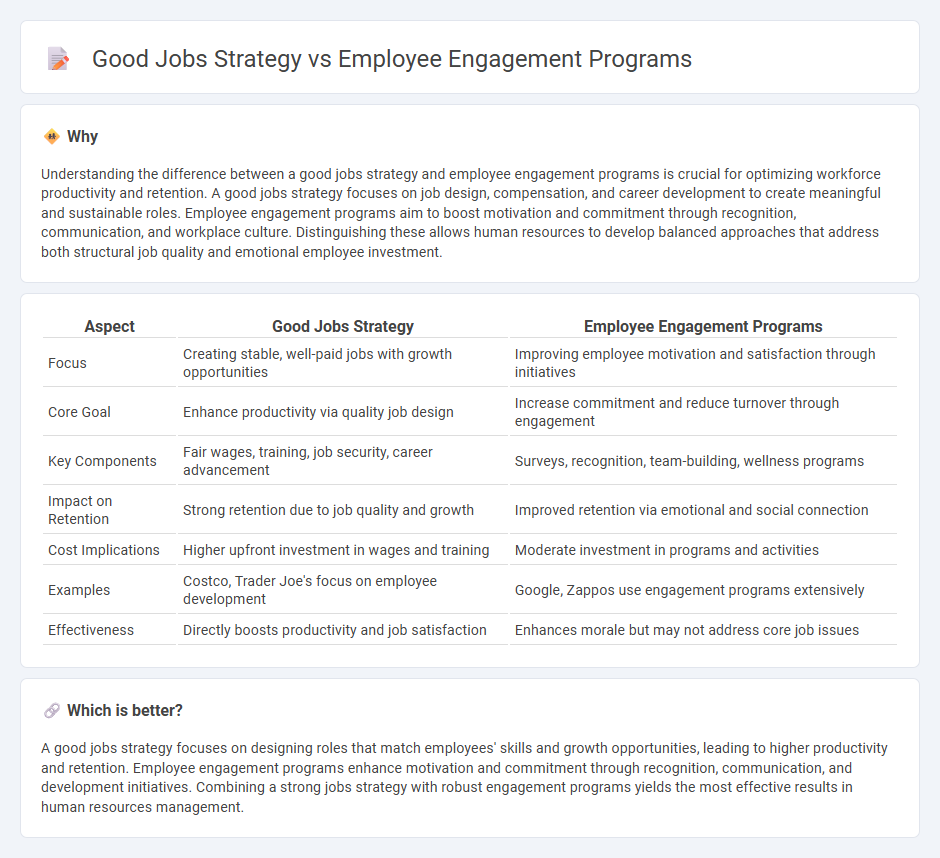
Effective human resources strategies balance robust job design with dynamic employee engagement programs to boost productivity and retention. Structured job roles clarify expectations, while engagement initiatives foster workplace motivation and satisfaction, driving overall organizational success. Explore proven methods to integrate job strategy and employee engagement for a competitive advantage.
Why it is important
Understanding the difference between a good jobs strategy and employee engagement programs is crucial for optimizing workforce productivity and retention. A good jobs strategy focuses on job design, compensation, and career development to create meaningful and sustainable roles. Employee engagement programs aim to boost motivation and commitment through recognition, communication, and workplace culture. Distinguishing these allows human resources to develop balanced approaches that address both structural job quality and emotional employee investment.
Comparison Table
| Aspect | Good Jobs Strategy | Employee Engagement Programs |
|---|---|---|
| Focus | Creating stable, well-paid jobs with growth opportunities | Improving employee motivation and satisfaction through initiatives |
| Core Goal | Enhance productivity via quality job design | Increase commitment and reduce turnover through engagement |
| Key Components | Fair wages, training, job security, career advancement | Surveys, recognition, team-building, wellness programs |
| Impact on Retention | Strong retention due to job quality and growth | Improved retention via emotional and social connection |
| Cost Implications | Higher upfront investment in wages and training | Moderate investment in programs and activities |
| Examples | Costco, Trader Joe's focus on employee development | Google, Zappos use engagement programs extensively |
| Effectiveness | Directly boosts productivity and job satisfaction | Enhances morale but may not address core job issues |
Which is better?
A good jobs strategy focuses on designing roles that match employees' skills and growth opportunities, leading to higher productivity and retention. Employee engagement programs enhance motivation and commitment through recognition, communication, and development initiatives. Combining a strong jobs strategy with robust engagement programs yields the most effective results in human resources management.
Connection
Effective job strategies directly influence employee engagement by aligning workforce skills with organizational goals, fostering job satisfaction and productivity. Strategic human resource planning ensures that roles are well-defined and meaningful, which enhances motivation and reduces turnover rates. Robust employee engagement programs reinforce this connection by promoting continuous feedback, career development, and recognition, ultimately driving business success.
Key Terms
**Employee Engagement Programs:**
Employee engagement programs foster a motivated and productive workforce by implementing targeted initiatives such as recognition schemes, professional development opportunities, and regular feedback systems. These programs directly enhance job satisfaction, reduce turnover rates, and improve overall organizational performance. Discover how investing in employee engagement can transform your workplace culture and drive sustainable success.
Recognition
Employee engagement programs often emphasize recognition through awards, incentives, and public acknowledgments to boost morale and productivity. In contrast, a good jobs strategy prioritizes meaningful job design, fair wages, and career development opportunities to provide intrinsic motivation and long-term commitment. Explore how integrating both approaches can maximize employee satisfaction and organizational success.
Feedback
Employee engagement programs prioritize continuous feedback mechanisms to enhance motivation, productivity, and job satisfaction by fostering open communication and addressing employee concerns promptly. Good jobs strategy emphasizes structured feedback as part of fair compensation, career development, and job security to ensure long-term employee well-being and retention. Discover more about how feedback integrates into effective workforce management strategies.
Source and External Links
Top 20 employee engagement initiatives to maximize workplace ... - Employee engagement programs are strategic initiatives--including open communication, skill development, wellness, and recognition--designed to foster commitment, enthusiasm, and a sense of value among employees, ultimately enhancing organizational performance and retention.
12 ideas for employee engagement programs - Achievers - Effective engagement programs offer recognition, points-based rewards, volunteer opportunities, and flexible work arrangements, aligning company values with employee behaviors to create meaningful, personalized experiences that drive motivation and retention.
8 HR Initiatives to Drive Employee Engagement - Leapsome - HR-led engagement initiatives focus on recognizing achievements, improving onboarding, career progression, team-building, wellness benefits, and regular feedback surveys to strengthen employees' connection to their work and the organization.
 dowidth.com
dowidth.com